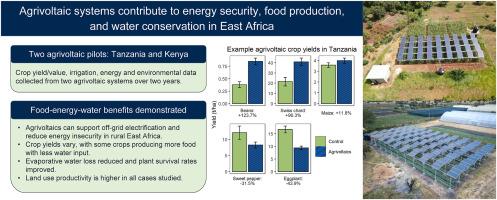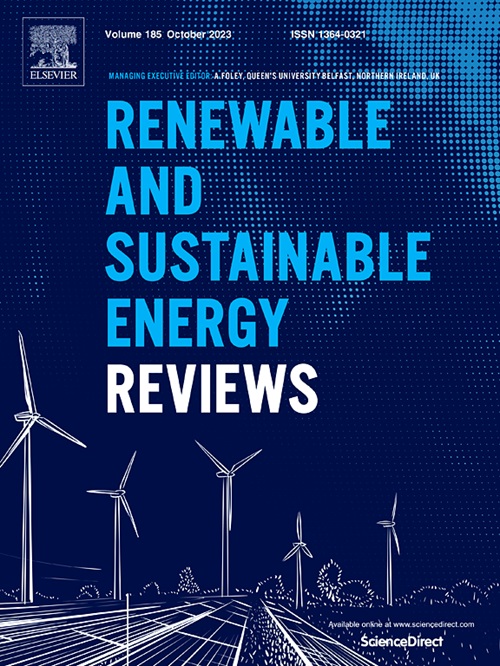Harvesting the sun twice: Energy, food and water benefits from agrivoltaics in East Africa
IF 16.3
1区 工程技术
Q1 ENERGY & FUELS
引用次数: 0
Abstract
Food, energy and water insecurity are concomitant challenges facing many communities in East Africa. Agrivoltaic systems – agriculture integrated with photovoltaic panels – address all three challenges, providing low carbon electricity, food production and water conservation on the same land area. Agrivoltaics have proven benefits for the food-energy-water nexus in the USA, Europe and Asia, but research is lacking in sub-Saharan Africa, where energy access remains low, and climate change and water scarcity threaten food systems. This study presents evidence for concomitant electricity generation, food production and water conservation from agrivoltaic systems in Tanzania and Kenya, demonstrating the viability of these systems for both grid-tied agribusinesses and rural, off-grid communities. Performance of some crops improved under agrivoltaics, generating higher incomes for farmers and agribusinesses while reducing energy bills and/or enhancing energy supply. Crop survivability during a warm period was greater under the agrivoltaic system, indicating potential for climate change resilience. Panel shading reduced irrigation demand, thus some crops achieved greater yields while needing less water input. Rainwater harvesting from panel runoff further reduced irrigation needs. Combining energy infrastructure with agriculture enhanced land productivity for all crops at both sites. Agrivoltaics, whether grid-tied or off-grid, could address multiple Sustainable Development Goals in East Africa simultaneously by contributing to energy security, climate change-resilient food production, and water conservation in the region.

二次收获阳光:东非农业光伏发电带来的能源、粮食和水效益
粮食、能源和水资源不安全是东非许多社区同时面临的挑战。农业光伏系统--农业与光伏板相结合--可以解决所有这三个挑战,在同一土地上提供低碳电力、粮食生产和水资源保护。在美国、欧洲和亚洲,农业光伏技术已被证明可为粮食-能源-水之间的关系带来益处,但在撒哈拉以南非洲地区却缺乏研究,那里的能源普及率仍然很低,气候变化和水资源短缺威胁着粮食系统。本研究提供了坦桑尼亚和肯尼亚的农业光伏系统同时实现发电、粮食生产和水资源保护的证据,证明了这些系统对并网农业企业和农村离网社区的可行性。在光伏农业系统的作用下,一些作物的长势得到改善,为农民和农业企业创造了更高的收入,同时降低了能源费用和/或增加了能源供应。在农业光伏系统下,农作物在温暖时期的存活率更高,这表明农业光伏系统具有抵御气候变化的潜力。面板遮阳减少了灌溉需求,因此一些作物在获得更高产的同时,需要的水量也更少。从面板径流中收集的雨水进一步减少了灌溉需求。能源基础设施与农业的结合提高了两个地点所有作物的土地生产力。无论是并网还是离网,农业光伏发电都可以同时实现东非的多个可持续发展目标,为该地区的能源安全、适应气候变化的粮食生产和水资源保护做出贡献。
本文章由计算机程序翻译,如有差异,请以英文原文为准。
求助全文
约1分钟内获得全文
求助全文
来源期刊

Renewable and Sustainable Energy Reviews
工程技术-能源与燃料
CiteScore
31.20
自引率
5.70%
发文量
1055
审稿时长
62 days
期刊介绍:
The mission of Renewable and Sustainable Energy Reviews is to disseminate the most compelling and pertinent critical insights in renewable and sustainable energy, fostering collaboration among the research community, private sector, and policy and decision makers. The journal aims to exchange challenges, solutions, innovative concepts, and technologies, contributing to sustainable development, the transition to a low-carbon future, and the attainment of emissions targets outlined by the United Nations Framework Convention on Climate Change.
Renewable and Sustainable Energy Reviews publishes a diverse range of content, including review papers, original research, case studies, and analyses of new technologies, all featuring a substantial review component such as critique, comparison, or analysis. Introducing a distinctive paper type, Expert Insights, the journal presents commissioned mini-reviews authored by field leaders, addressing topics of significant interest. Case studies undergo consideration only if they showcase the work's applicability to other regions or contribute valuable insights to the broader field of renewable and sustainable energy. Notably, a bibliographic or literature review lacking critical analysis is deemed unsuitable for publication.
 求助内容:
求助内容: 应助结果提醒方式:
应助结果提醒方式:


